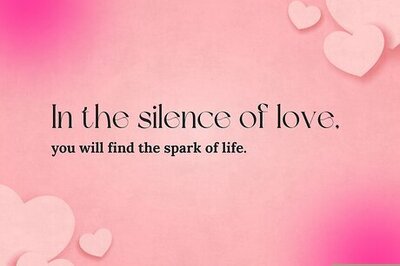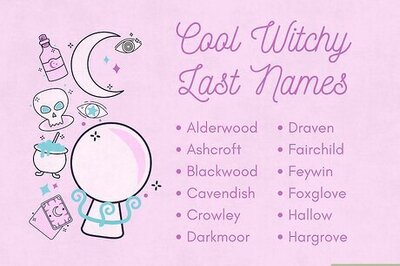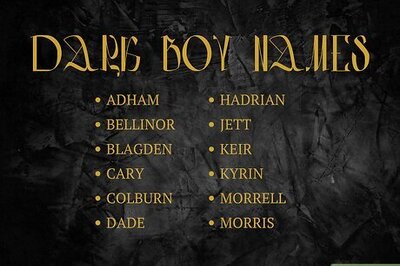
views
Reiki Symbols
Reiki symbols represent specific energy frequencies. Reiki is a type of Japanese energy healing in which symbols are used to enhance and direct energy during sessions. Each symbol is tied to a different energy frequency, and Reiki practitioners draw or encourage visualization of these symbols to manifest subsequent healing. The five traditional Reiki symbols are: Cho Ku Rei - This spiraling symbol is used to summon power and energy for the purposes of boosting healing. It’s also used to unblock the chakras! Sei He Ki - This Reiki symbol is used to connect two bodies: the conscious and subconscious, or mental and emotional. In religious contexts, it also connects God and man. It’s intended to soothe users and help them release negative emotions. Hon Sha Ze Sho Nen - This symbol is used to heal across any distance, including time and space. It translates to “no past, no present, no future.” Dai Ko Myo - This Reiki symbol is intended to enhance a person’s awareness, helping them to discover their healing journey. It translates to “great shining light.” Raku - This symbol is traditionally used at the end of a Reiki session to preserve healing energy and its ongoing effects.
Rod of Asclepius
The rod of Asclepius is a Greek symbol of healing. It dates back to the days of ancient Greece, where it was a symbol associated with Asclepius, the Greek god of healing. It’s depicted as a snake curled around an upright rod or staff; the serpent represents rejuvenation, while the rod represents the power of healing. Though it’s often confused with the Caduceus, the rod of Asclepius has much stronger ties to healing and rebirth in historical contexts. The rod of Asclepius remains a popular symbol of healing today! You may have seen it used in modern logos—including that of the World Health Organization.
Caduceus
The Caduceus is an ancient symbol misinterpreted to represent healing. Odds are you’ve seen this Grecian symbol represented in various medical logos—including on the flag U.S. Army’s Surgeon General. Funnily enough, the Caduceus didn’t always represent healing; in ancient Greece, it was a symbol of Hermes (the god of messengers and commerce). However, it’s often confused with the rod of Asclepius and thus came to be known as a healing symbol. The Caduceus is most commonly used as a healing symbol in the Western world (particularly the United States). In the context of healing, the Caduceus’ two snakes represent balance and harmony, and the wings represent speed or swiftness.
Yin Yang
The Chinese Yin Yang symbol represents balance. It’s depicted with a perfect circle made up of two opposing halves: one black with a smaller white circle inside (Yin) and the other white with a smaller black circle inside (Yang). Yin is traditionally associated with feminine energy, peace, and coolness, while Yang is associated with heat, movement, and masculine energy. As a whole, this symbol embodies the idea that both energies are needed for balance and healing. The Yin Yang is also used in traditional Chinese medicine to encourage spiritual and physical healing.
Om
The Om symbol is traditionally used for healing and spiritual meditation. “Om” is more than a sound made during meditation; it’s also a sacred symbol within Hindu, Buddhist, and Jainist practices, representing the essence of the universe and the three states of consciousness: waking, dreaming, and deep sleep. When spoken aloud, “Om” is said to vibrate at the universe’s natural frequency, which is why it’s believed to bring relaxation and awareness. Visually, the symbol for “Om” is represented by a combined semicircle, dot, and three connecting curves.
Lotus
The Lotus plant is used to treat different medical ailments. In traditional medicinal practices like Ayurveda, different parts of the Lotus are used in various treatments. Additionally, the Lotus flower is associated with meditation exercises to encourage healing and serenity. Thus, the Lotus flower has become a symbol for healing, as well as purity, enlightenment, and rebirth. Buddhist art typically depicts a Lotus flower with a Buddha or Bodhisattva sitting on it, which symbolizes reaching a place of enlightenment.
Healer’s Hand
The Healer’s Hand is a Native American symbol of healing and life. As the name suggests, this symbol is depicted as a hand with a spiral coming from the palm; it was first found in Native American hieroglyphics and is typically used in Reiki or other healing practices. In Native American tradition, the Healer’s Hand represented human life and was said to transmit healing energy to an individual with that symbol on them. This symbol is also known as the “Hopi hand” or “Shaman’s Hand.” The Hopi are a Native American people who mainly live in northeastern Arizona today.
Spiral Sun
The Spiral Sun is another Native American healing symbol. However, it appears in different forms all around the world! It’s believed that the Spiral Sun originated in petroglyphs (images carved into rocky surfaces) and artifacts from the Anasazi (ancestral Puebloan people who lived in southwest America), and was associated with healing because the Anasazi people believed in the sun’s healing abilities. There’s a similar sun symbol originating from Ghana (in Africa) called the Owia Kokroko, which also represents healing, as well as renewal, and the need for light to support life.
Tree of Life
The Tree of Life is ancient, with many symbolic meanings. The Tree of Life’s meanings vary across different cultures and traditions; it symbolizes growth and the interconnectedness of the universe, as well as fertility, regeneration, healing, and balance of the mind, body, and spirit. Visually, it’s depicted as a great tree with roots that spread deep into the ground and branches reaching up into the sky, connecting the earth (physical world) to the heavens (spiritual world). Some cultures also associate the Tree of Life with creation myths of the universe. In Celtic traditions and mythology, the Tree of Life was used in ceremonies to mark the change of seasons and other natural cycles.
Sri Yantra
The Sri Yantra is a sacred Indian symbol representing the universe’s energy. The Sri Yantra is comprised of nine interlocking triangles (which, in turn, form 43 smaller triangles), surrounded by two rings of lotus flowers. It’s believed that using the Sri Yantra can help balance one’s chakras within their body, as each level of the symbol corresponds to a mudra—a ritual pose—in Buddhist and Hindu tradition. One level of the Sri Yantra (the Sarva Rogahara, comprised of eight small triangles) is specifically dedicated to healing and protection from physical and spiritual ailments.
Flower of Life
The Flower of Life is a symbol of sacred geometry. Its structure is made from overlapping circles that create a pattern resembling flowers, making it a symbol of unity and interconnectedness. It has significance in many ancient cultures, from China to Egypt, India, and beyond. Although its symbolism is related to unity, it’s also used in spiritual healing practices—including meditation and energy healing. The use of the Flower in meditation and energy healing is said to balance the body, mind, and spirit; thus, the Flower of Life can be considered a healing symbol!
Seed of Life
The Seed of Life is a building block within the Flower of Life’s structure. The Seed of Life consists of seven overlapping, same-sized circles, wherein each circle represents one of the seven days of creation. It’s a foundational part of the Flower of Life, and thus is also used in meditation and spiritual healing practices; in many cultures, it represents creation and energy. Thus, it’s used by people wanting to invite that energy into their lives.
Eternal Knot
The Eternal Knot is a symbol of interconnectedness and continuity. It exists across many traditions, including Buddhist, Hindu, Jainist, Celtic, and Chinese cultures; thus, it’s associated with several different meanings as well. For instance, it relates to the interconnectedness of the universe and all beings, wisdom, compassion, and the endless cycle of life, death, and rebirth. The Eternal Knot also relates to healing because it’s sometimes used as a focal point for meditation and related spiritual practices. It’s a symbol of healing and comfort for those experiencing grief as well; it represents love and connectedness enduring beyond time and space.
Hamsa
The Hamsa promotes healing, as well as protection and luck. It’s primarily a Jewish and Muslim symbol—a hand-shaped amulet typically decorated with Hebrew or Arabic script, respectively. It’s known as the “Hand of Miriam” (the sister of Moses) in Jewish tradition, associating it with strength and wisdom; meanwhile, Muslim tradition calls it the “Hand of Fatima” (the daughter of Muhammad), and associates it with generosity and love. So, why is the Hamsa a healing symbol? Well, when worn as a talisman or hung up in places, it’s believed to protect people from negative energy and promote healing.
Mandala
Mandalas are complex symbols made from basic geometric shapes. In Hindu and Buddhist traditions, mandalas can represent a number of things—including a person’s journey through life, their chakras, and the universe. They’re often used in meditation and spiritual healing practices to invoke serenity and calm, helping those who practice meditation focus their minds as they work.
Eye of Horus
Ancient Egyptians believed the Eye offered healing and protection. The Egyptian god Horus ruled over the sun and moon. In one legend, Set, the god of deserts and violence, took Horus’s eye during a battle. Later, the god of wisdom (Thoth) restored Horus’s eye—and thus, the symbolic Eye of Horus was believed to have protective powers in ancient Egypt, as well a restorative healing abilities.
Star of David
The Jewish Star (or Shield) of David can also be a healing symbol. The Star of David is a six-pointed star made from two triangles—one pointed up, the other down. While the Star of David is most often seen as a symbol of the Jewish faith, it’s also believed to have protective and healing properties. In fact, some even believe the Star’s shape represents the elevation of one’s consciousness while remaining grounded.
Unalome
The Unalome represents a person’s journey or spiritual path. The unalome can symbolize a path through life, or a journey to enlightenment. Its intricate spirals and loops represent the challenges that arise in life, while its straight line and dots symbolize the attainment of enlightenment. In Buddhist tradition, the unalome also represents spiritual balance—and in Hindu tradition, it’s a symbol of obstacles removed from one’s life. Thus, the unalome can represent a path to healing at the end of various challenges, and serve as a reminder that healing is a process that sometimes comes with hurdles; it’s not necessarily a straight path forward.
Infinity
Infinity represents not only eternal life, but also regeneration. You’ve probably seen the infinity symbol before (depicted as a sideways “8”), but its meaning is actually layered. It represents endlessness (the concept of infinity, a line that never ends), but in spiritual contexts, it can also symbolize regeneration and never-ending life, which can, in turn, relate to healing.
Dharma Wheel
The Dharma Wheel is a symbol of the Buddhist Eightfold Path. Each spoke represents an aspect of the Path—understanding, speech, action, livelihood, effort, mindfulness, and concentration. In the Buddhist tradition, it’s believed that each aspect of the Path is essential to reaching enlightenment. Additionally, the wheel’s hub represents discipline, while the rim represents the perfection of wisdom. The Dharma Wheel can be considered a symbol of healing because it’s typically used in meditation and other spiritual practices. Additionally, the wheel’s circular shape as a whole represents the cycles of existence, including chance and rebirth.



















Comments
0 comment